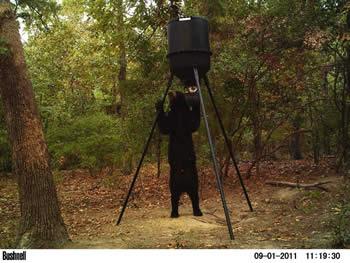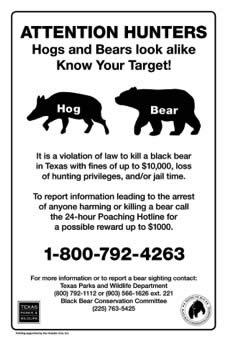 October 23, 2015 - East Texas Black Bear Task Force (ETBBTF) encourages East Texas residents and hunters to report possible black bear sightings
October 23, 2015 - East Texas Black Bear Task Force (ETBBTF) encourages East Texas residents and hunters to report possible black bear sightings
As cool temperatures enter eastern Texas and hard masts begin to drop, white-tailed deer and eastern wild turkeys may not be the only native species seeking nutrient-dense acorns in preparation for winter.
Over the past 40 years, the black bear, whose historic range once spanned nearly all of Texas, has begun to reappear in portions of its native East Texas territory after original populations were devastated by loss of habitat and unregulated harvesting throughout the 19th and 20th centuries.
The growing regional bear populations in the adjacent states of Arkansas, Oklahoma and Louisiana have resulted in a natural, slow return of the species to eastern Texas in small numbers. There is currently no established breeding population of black bears in East Texas, and scientists believe the majority of confirmed sightings are primarily transient males.
“A part of our natural heritage is slowly returning to Texas,” said Sarah Fuller, vice-chair of the East Texas Black Bear Task Force. “Currently, our primary goal is to proactively educate the public regarding this native species and dispel any misconceptions that may be present.”
The Texas Parks and Wildlife Department began documenting black bear sightings and deaths in 1977, and since that time, the number of sightings has increased in certain portions of East Texas. In September 2011, an adult female bear was photographed on private property in Red River County.
Because there is no confirmed breeding population in the region, research has focused on East Texan’s attitudes towards bears, as well as the requirements of suitable bear habitat and habitat availability within the region.
 “It is imperative that individuals who believe they have seen or have evidence of a black bear contact Texas Parks and Wildlife as soon as possible,” said Nathan Garner, interim chair of the East Texas Black Bear Task Force.
“It is imperative that individuals who believe they have seen or have evidence of a black bear contact Texas Parks and Wildlife as soon as possible,” said Nathan Garner, interim chair of the East Texas Black Bear Task Force.
Garner explained that these reports provide wildlife authorities with a more precise idea of the number of bears in the area and aid natural resource agencies and wildlife biologists in developing management decisions.
As black bears are still rare in eastern Texas, wildlife biologists from Texas Parks and Wildlife investigate alleged sightings to confirm or refute the observation. After the investigation concludes, sightings are divided into one of three classifications.
Garner emphasized that landowners are in no way obligated to implement any sort of special management practice if a sighting is reported on their land. Within the past decade, multiple landowners have provided photographs of black bears taken by motion sensitive cameras mounted at deer feeders. Hunters are encouraged to report sightings and to “know your target,” because from a distance, a black bear can be mistaken for a feral hog.
To report a possible bear sighting in East Texas, call Texas Parks and Wildlife at 903-566-1626 ext. 209. It remains illegal to kill or harm a black bear in Texas, with violations carrying significant fines, jail time and/or loss of hunting privileges.
Garner stressed that black bears co-exist with people in several states across the nation, included densely populated states like New Jersey, and can undoubtedly co-exist with Texans.
“Biologists with Stephen F. Austin State University have identified approximately one million acres of suitable black bear habitat in East Texas, so there is room for black bears in our forests,” he said.
Founded in 2005, the East Texas Black Bear Task Force is a non-profit coalition of state, federal, private industry, and private citizens who seek to support the restoration of the black bear in its historic range of East Texas through education, research and the creation of a well-informed public.
Information regarding black bears in East Texas as well as the East Texas Black Bear Task Force may also be found on the organization’s Facebook page.









